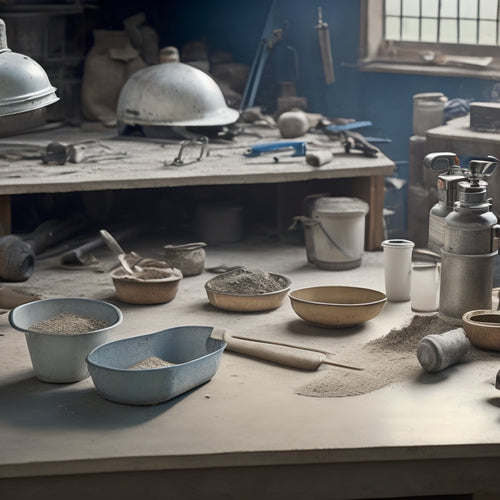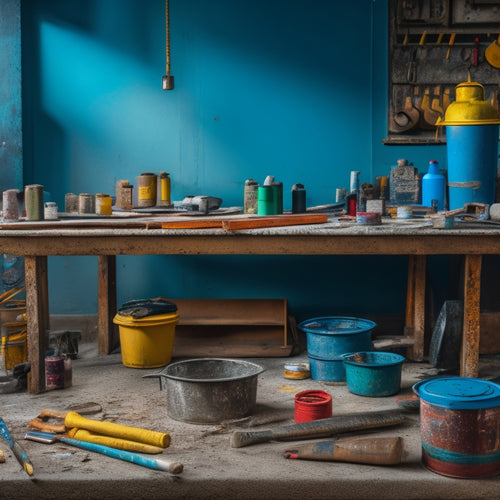
Top Tools for Building Concrete Walls
Share
You'll need a range of specialized tools to build a solid, durable, and attractive concrete wall. For mixing, you'll require a concrete mixer, mixing drum, shovel, cement scale, and water meter. Formwork and molding tools, such as formwork panels, molding profiles, and molding machines, will help you create the desired shape and design. To finish and smooth the concrete, you'll need a bull float, darby, surface treatment, level, and straightedge. Additionally, you should consider reinforcement and anchoring systems, as well as essential safety gear like protective gloves, safety goggles, and a dust mask. Now that you have an overview of the top tools, you're ready to start building a robust and efficient concrete wall structure.
Key Takeaways
• A concrete mixer is essential for combining cement, aggregates, and water in correct proportions for a strong and durable wall.
• Formwork and molding tools like formwork panels, molding profiles, and molding machines help create the desired shape and design for the wall.
• Concrete finishing and smoothing tools like bull floats, darby/tamping tools, and surface treatment are necessary for a smooth and even finish.
• Reinforcement and anchoring systems including rebar, anchors, tiebacks, and brackets provide structural integrity and stability to the wall.
• Safety gear and protective wear like protective gloves, safety goggles, dust masks, and steel-toed boots are crucial for preventing injuries and ensuring a safe working environment.
Essential Equipment for Mixing
To guarantee a strong and durable concrete wall, you'll need the right equipment to mix your materials effectively.
A concrete mixer is a must-have, as it allows you to combine cement, aggregates, and water in the correct proportions.
You'll also need a mixing drum or bucket to hold the materials, as well as a shovel or scoop to measure and add the ingredients.
Depending on the material types you're working with, you may require additional equipment, such as a cement scale to accurately measure the cement content or a water meter to control the water flow.
Additionally, adopting efficient mixing techniques is vital to achieve a uniform mix.
You can opt for manual mixing, using a mixing stick or trowel, or invest in a power mixer for larger projects.
Formwork and Molding Tools
With your concrete mix ready, you'll need to create a mold to shape it into the desired wall structure, and that's where formwork and molding tools come in. These tools are essential for creating the desired shape and structure of your concrete wall.
Formwork types include traditional timber formwork, modular formwork, and insulated concrete formwork (ICF). Modular formwork is a popular choice due to its reusability and ease of assembly.
Here are some essential formwork and molding tools to take into account:
-
Formwork panels: Used to create the mold for your concrete wall, these panels come in various materials, including timber, steel, and aluminum.
-
Molding profiles: Used to create curved or decorative edges, molding profiles add a touch of sophistication to your concrete wall.
-
Formwork accessories: Items like formwork ties, nuts, and washers are used to secure the formwork panels in place.
- Molding machines: Used for complex molding techniques, these machines can create intricate designs and patterns on your concrete wall.
Concrete Finishing and Smoothing
You'll need to finish and smooth the concrete surface once it's been poured into the mold and allowed to set. This vital step guarantees a strong, durable, and visually appealing wall.
To achieve a smooth finish, you'll employ various trowel techniques. Start with a bull float to remove excess water and flatten the surface. Next, use a darby or tamping tool to flatten and smooth out the concrete, removing any air pockets or imperfections. For a high-gloss finish, apply a surface treatment, such as a concrete sealer or wax, to protect the surface and enhance its appearance.
As you work, pay attention to the concrete's consistency and temperature, as these factors affect the final result. Use a level to verify the surface is even and a straightedge to check for any deviations.
With the right techniques and tools, you'll achieve a smooth, professional-looking finish that's essential for a strong and durable concrete wall. By mastering concrete finishing and smoothing, you'll be able to create high-quality walls that meet your project's specifications and requirements.
Reinforcement and Anchoring Systems
To guarantee the concrete wall can withstand various loads and stresses, it's vital to incorporate a robust reinforcement and anchoring system into your design. This system will provide the necessary strength and stability to support the wall's weight and resist external forces.
You'll need to select the right reinforcement techniques and anchoring methods to make certain your wall can handle the expected loads.
Here are some essential components to take into account:
-
Rebar: A lattice of steel bars that adds tensile strength to the concrete.
-
Anchors: Devices that secure the wall to the foundation or adjacent structures.
-
Tiebacks: Cables or rods that anchor the wall to the surrounding soil or rock.
- Brackets: Metal supports that connect the wall to the foundation or other structural elements.
Safety Gear and Protective Wear
As you move on to constructing the concrete wall, don't forget to gear up with the necessary safety equipment and protective wear to prevent injuries and assure a secure working environment. Concrete construction can be hazardous, with risks of skin irritation, eye damage, and physical harm from heavy materials and equipment.
You'll need protective gloves to shield your hands from harsh chemicals, abrasions, and cuts. Look for gloves with grip patterns to prevent slipping and provide dexterity for handling tools.
Safety goggles are also essential to protect your eyes from cement dust, flying debris, and chemical splashes. Make sure they fit comfortably and provide clear vision.
Additionally, consider wearing a dust mask or respirator to prevent inhalation of cement particles and other airborne contaminants. Steel-toed boots and a hard hat can also provide extra protection.
Don't overlook the importance of high-visibility vests, especially when working in low-light conditions. By wearing the right safety gear and protective wear, you'll be well-prepared to tackle the demands of concrete wall construction.
Frequently Asked Questions
Can I Build a Concrete Wall Without Professional Experience?
You can build a concrete wall without professional experience, but it's essential to follow DIY techniques and beginner tips, ensuring proper mixing, pouring, and curing to achieve a structurally sound and durable wall.
How Do I Ensure the Wall's Structural Integrity Over Time?
You maintain the wall's structural integrity over time by considering load-bearing factors, implementing reinforcement techniques like rebar or fiber mesh, and following local building codes and regulations to guarantee a safe and durable structure.
Are There Any Eco-Friendly Alternatives to Traditional Concrete?
You're looking for eco-friendly alternatives to traditional concrete. Consider using sustainable materials like recycled aggregate, fly ash, or slag cement, which reduce environmental impact. Green technology innovations, such as carbon capture or 3D printing, also offer promising solutions.
Can I Use Concrete Walls for Soundproofing or Insulation?
Like the Great Wall of China, you're building a barrier, but this time, against noise and heat; yes, you can use concrete walls for soundproofing or insulation, employing techniques like mass-spring-mass and incorporating materials like fiberglass or foam insulation.
Do Concrete Walls Require Regular Maintenance or Upkeep?
You'll need to perform regular crack repair and guarantee moisture control to prevent water damage, as concrete walls can be prone to cracking and moisture issues, requiring ongoing upkeep to maintain their integrity.
Conclusion
You've made it to the final layer of your concrete wall construction. As you step back to admire your handiwork, you can't help but feel a sense of pride and accomplishment.
But don't be fooled - without the right tools, your wall would be nothing more than a heap of rubble.
You may think, 'I can just wing it and figure things out as I go,' but trust us, that's a recipe for disaster.
With the right tools, you've not only guaranteed a sturdy structure, but a tribute to your expertise.
Related Posts
-

What Tools Do You Need for Concrete Success
For concrete success, you'll need a range of essential power tools, including rotary hammers, angle grinders, concret...
-

Essential Tools for Painting Concrete Walls
When painting concrete walls, you'll need a range of specialized tools to achieve a professional-looking finish. Star...
-

Why These Concrete Tools Are Always in Demand
You rely on a set of trusted concrete tools to deliver high-quality results, and it's not surprising - these tools ar...


